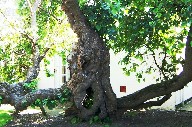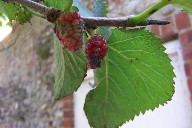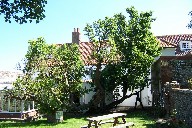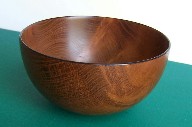| |
 
THE
MAGNIFICENT MULBERRY
 |
|
On Thursday 19
July I was standing in the welcome shade
of a fine young mulberry tree hard by the
east end of Tewkesbury Abbey in
Gloucestershire. The fruit
wasn’t ripe, so that there was no
mess on the ground - the biggest problem
with mulberry trees, as the juice from
the ripe fruit stains everything it comes
into contact with for weeks.
Just twenty-four hours later flood water
was lapping round the tree’s roots,
and my car, less than a hundred yards
away, would have been six feet under
water.
A few weeks later I was in Norfolk, where
I found another mulberry
tree. This one was at least
two hundred and fifty years old and well
past its prime. But it still
bore some fruit, large berries which I
always describe as exploding loganberries
on account of their
juiciness. Although very
similar to look at, they are much
sweeter, and, believe it or not, more
closely related to figs than to the
raspberry family. |
There are three varieties
of mulberry, white, red and black, though the
last two are very similar even though one is
native to southwest Asia and the other to North
America. The white mulberry is
another Asian species, and is the main source of
food for the silkworm, the pupa of which is used
to make silk. Hence the popularity of
the Silk Route across Europe and Asia in the
Middle Ages.
There are many
early references to the tree. We read in
the Psalms, for example, that the
Almighty destroyed the mulberry trees
with frost, but this must be a
mistranslation, as the tree had not been
introduced into Palestine in Old
Testament times.
The Roman writer, Ovid, tells how the
lovers Pyramus and Thisbe communicated
through a crack in the wall separating
their houses, a story repeated by
Shakespeare in A Midsummer Night’s
Dream. One night they eloped
and Thisbe was frightened away from their
rendez-vous, a white mulberry tree, by a
lion which had obviously just finished a
meal. She escaped and hid,
but in doing so left her cloak behind to
be mauled by the lion.
Pyramus, finding the apparently
blood-stained cloak and thinking the
worst, impaled himself on his sword, and
in doing so his blood turned the
mulberries red, and so the western fruits
have remained to this day. |
|
 |
 |
|
It is the black
species that thrives best in
Britain. In 1608 King James
I, anxious to promote the silk industry,
issued an edict encouraging the
cultivation of mulberry
trees. The ensuing attempt to
rear silkworms was unsuccessful, however,
because black mulberries were grown in
error, whereas it is the white mulberry
on which silkworms flourish.
Another strange mulberry story came to
light recently. Publicity
around the exhibition of the Queen’s
Diamond Wedding suggested that her
wedding dress was made of silk from
Chinese silkworms. But a
letter to a national paper pointed out
that Lady Hart Dyke of Lullingstone
Castle in Kent had silkworms and that
local people with mulberry trees were
asked to help by supplying big hampers of
leaves to feed them. In due
course, each provider received a tiny
sample of the beautiful material used for
the dress. |
Finally, what
about the nursery rhyme “Here we go
round the mulberry bush?”
Apparently it was a children’s game
invented by washerwomen to amuse and
teach their children. Originally it
was “Here we go round the bramble
bush” and chanted by Yorkshire
children as they danced round one child
who was the bramble bush. In
the 1750s Wakefield Jail had both women
and child prisoners, and since there was
a mulberry tree in the grounds, the words
were changed to suit the location.
Mulberry trees are scarce today, and the
wood, with its beautiful grain, is much
sought-after by wood turners. I
wonder how many there are in
Petersfield? Not that I will
be making mulberry jam, much as I love
it, but I would like to thank those
readers who informed me of the
whereabouts of quince trees in the
town. I ‘ve been peeling
them a lot recently! |
|
 |
Tom Muckley, October 2007
This article was originally
published by the
Petersfield Post
tommuckley.co.uk
|
|





